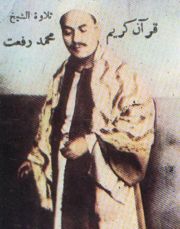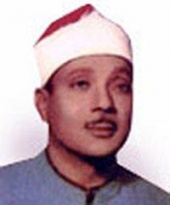Difference between revisions of "Islamic performance genres"
| Line 37: | Line 37: | ||
| − | * [http://www.fwalive.ualberta.ca/~michaelf/MR/Chanting%20devotion/Islamic/Cue%207.mp3 Qur’anic recitation (mujawwad)]. Performed by Shaykh Muhammad | + | * [http://www.fwalive.ualberta.ca/~michaelf/MR/Chanting%20devotion/Islamic/Cue%207.mp3 Qur’anic recitation (mujawwad)]. Performed by Shaykh Muhammad Rif‘at ((May 9, 1882 - May 9, 1950), the earliest great reciter to be |
recorded in Egypt, during the early part of this century. This is again the mujawwad style; note the pauses, | recorded in Egypt, during the early part of this century. This is again the mujawwad style; note the pauses, | ||
repeats, slow delivery, melisma, melodic inventiveness. This style allows the performer to create maximal | repeats, slow delivery, melisma, melodic inventiveness. This style allows the performer to create maximal | ||
| − | emotional power. [[Image:180px-Great_Rifat.jpg|thumb]] | + | emotional power. [[Image:180px-Great_Rifat.jpg|thumb|Shaykh Muhammad Rif`at]] |
* [http://www.fwalive.ualberta.ca/~michaelf/MR/Chanting%20devotion/Islamic/Cue%208.mp3 Qur’anic recitation (mujawwad)]. Performed by Shaykh ‘Abd al-Basit ‘Abd al-Samad. A great Egyptian | * [http://www.fwalive.ualberta.ca/~michaelf/MR/Chanting%20devotion/Islamic/Cue%208.mp3 Qur’anic recitation (mujawwad)]. Performed by Shaykh ‘Abd al-Basit ‘Abd al-Samad. A great Egyptian | ||
reciter who passed away relatively recently (1927-1988). Note how each reciter has his style. This too is the | reciter who passed away relatively recently (1927-1988). Note how each reciter has his style. This too is the | ||
| − | mujawwad style. [[Image:170px-Abdul_basit.jpg]] | + | mujawwad style. [[Image:170px-Abdul_basit.jpg|thumb|Shaykh `Abd al-Basit `Abd al-Samad]] |
* [http://www.fwalive.ualberta.ca/~michaelf/MR/Chanting%20devotion/Islamic/Cue%209.mp3 Qur’anic recitation (murattal)]. Performed by Shaykh Ahmad al-‘Ajami, from Saudi Arabia. Note the | * [http://www.fwalive.ualberta.ca/~michaelf/MR/Chanting%20devotion/Islamic/Cue%209.mp3 Qur’anic recitation (murattal)]. Performed by Shaykh Ahmad al-‘Ajami, from Saudi Arabia. Note the | ||
Revision as of 11:08, 27 September 2007
Islamic religious performance traditions of Egypt: Tilawa, ibtihalat, adhan, ad`iyya, tawashih, dhikr, aghani diniyya, inshad
Notes by Michael Frishkopf.
The dawn prayer rite (salat al-fajr)
The next four examples are taken from an Egyptian radio broadcast, starting before the dawn prayer (fajr). The following sequence is broadcast daily from one of the main mosques: (a) Qur’anic recitation, (b) vocalized supplications (ibtihalat), (c) call to prayer (adhan) at dawn, (d) more Qur’anic recitation preceding group prayer, (e) the prayer rite itself (salat al-fajr).
- Qur’an recited before fajr prayer (end). The style is mujawwad (the melodically elaborate form of
tajwid, Qur’anic recitation). From Qur’an 2:231-232. Reciter: Shaykh Salah ‘Abd al-Razzaq Shams al- Din. The excerpt is taken from near the end of his recitation, which may last half an hour altogether. Note how he descends from Rast on G to Bayyati on D. Recitation typically starts low, moves higher, and then descends again, in the arc shape characteristic of so much improvisation in the maqamat.
- Ibtihalat (sung supplications; start). Performed by Shaykh ‘Awwad Abu Layla. Note differences
between ibtihalat and Qur’anic recitation. Ibtihalat is based on supplicatory phrases and poetry; the text is not Divine Revelation. More melody and melisma is possible, because there are no rules (the rules of tajwid) governing the recitation, which is consequently much freer.
- Ibtihalat and adhan. Same performer. Note how the end of the ibtihalat merges seamlessly into the
morning call to prayer, or adhan, in the same style.
- Ad‘iyya (prayers of request; singular: du‘a’). These call and response prayers are performed towards
the end of the morning prayer; the imam (leader) recites a prayer and all respond “Amin”.
Qur'anic recitation (tilawa)
Young Iranian boy reciting in Shaykh `Abd al-Basit's style
- Qur’anic recitation (mujawwad). Performed by Shaykh Muhammad Rif‘at ((May 9, 1882 - May 9, 1950), the earliest great reciter to be
recorded in Egypt, during the early part of this century. This is again the mujawwad style; note the pauses, repeats, slow delivery, melisma, melodic inventiveness. This style allows the performer to create maximal
emotional power.- Qur’anic recitation (mujawwad). Performed by Shaykh ‘Abd al-Basit ‘Abd al-Samad. A great Egyptian
reciter who passed away relatively recently (1927-1988). Note how each reciter has his style. This too is the
mujawwad style.- Qur’anic recitation (murattal). Performed by Shaykh Ahmad al-‘Ajami, from Saudi Arabia. Note the
contrast with the previous two examples: here, recitation is rapid, narrower in melodic scope, little melisma, always moving forward without pauses. This style, called murattal, was traditionally used for study and private devotions. Recently it has become more popular for listening, probably due to Egyptian worker migration to Saudi Arabia, as well as increasing religious conservatism; the conservatives critics often condemn the older mujawwad style as “singing” the Qur’an. From a commercial recording.
Inshad dini
- Ibtihalat. Performed by Shaykh Taha al-Fashni, probably the most famous mubtahil of the 20th c. Here
ibtihalat is based entirely on poetry. The recording is different from the dawn-prayer style heard above. From Sono Cairo 67028/601.
- Tawashih diniyya. Performed by Shaykh Muhammad al-Fayyumi and his bitana (chorus). Tawashih
involve alternation between solo and chorus; the former improvisatory, the latter more precomposed and quasi-metric. From Sono Cairo 75113/461.
Sufi performance
- Sufi dhikr with inshad. Recorded during the 1932 Arabic music conference by the celebrated Laythi
order (Egyptian), led by Shaykh Basatini. The dhikr consists of chanting the Names of God (here, “Allah”); inshad (singing of religious poetry) is often superimposed, either solo or group. Early recordings such as these are not field recordings, but took place in studio-like conditions, and under limitations of length (due to the length of a phonograph disc).
- Sufi dhikr with inshad. Field recording made in 1998 of a contemporary Egyptian Sufi order, the
Hamidiyya Shadhiliyya. The group chants “Allah” while a soloist and chorus performs inshad. Note how emotional power is generated by inshad, and how it is timed to move with dhikr. The Sufi orders tend not to use instruments.
- Ad‘iyya (prayers of request) following Ramadan tarawih prayers. Performed by Shaykh Muhammad Jabril. During Ramadan
lengthy ad‘iyya are performed at the conclusion of the late-night tarawih prayers. These are particularly important during the last 10 nights, since one of these is the “laylat al-qadr” or “night of power”, during which channels between heaven and earth are open. Shaykh Muhammad Jabril has become the most famous reciter of this type. The style is similar to that of the morning prayer, but with much greater emotional intensity and buildup, partly due to the size of the congregation (exceeding 50,000). This is a recent phenomenon due to the rise of interest in religion, together with technical innovations such as the amplifier, allowing the voice to be projected over an expansive area.
- Orchestral inshad (religious song). Performed by Shaykh Sayyid al-Naqshabandi with chorus and
orchestra. Here is an example of transformation of the older ibtihalat and tawashih traditions. Shaykh Naqshabandi became famous through media appearances. Formerly he performed in the traditional vocal style, which was later augmented with orchestra and fixed arrangements. Note the focus on nay (reed flute), whose sound is a symbol of Islamic mysticism and contemplation, as well as the duff (frame drum), which is specially sanctioned by Prophetic traditions in Islamic music.
- Aghani diniyya (religious songs performed by ordinary singers=mutribin). Performed by ‘Abd al-Halim
Hafez. ‘Abd al-Halim was Egypt’s Elvis, an extremely popular singer of romantic songs; he did not train in the religious tradition and has no status as “shaykh”. However during religious holidays he might sing religious material; this tape is an example. It cannot be considered pure inshad dini, since the context, style, and performer do not certify the performance as a true devotional act. The nay is used to mark the performance as religious, and the mood is subdued, with little meter; but vocal style is similar to ‘Abd al- Halim’s standard popular fare.
- Sufi inshad in the public hadra. Performed by Shaykh Yasin al-Tuhami, from Assiut, in Upper Egypt; live performance
from Mahalla, in the Egyptian Delta. Over the last 20 years Sufi munshidin have started to emerge as major singing stars, recorded on commercial tapes and singing professionally in a wide variety of social settings. The most famous of these is Shaykh Yasin al-Tuhami. He typically performs with a small takht (here including violin, kawala (another reed flute), and percussion), draws heavily on secular music (especially Umm Kulthum) for melodic material, instrumentation, and style, while performing classical Sufi poetry in a Sufi setting. Performance includes development of maqamat, taqasim, vocal improvisation, lawazim (melodic fills), qafla and many other features of the tarab style. As for Shaykh Muhammad Jabril, the advent of the PA system was important to the development of this genre of performance. Melodic material is improvised, but draws on standard phrases. His performances are generally attended by hundreds or even thousands (especially in the larger saint festivals, called mawlids); some listen, while others form lines in order to perform the dhikr while listening to his performance (you can hear the chantin this recording), and generate a powerful ecstatic mood. Here he sings a poem of the great 13th c mystical poet Ibn al-Farid, in his 18th commercial tape, of which there are approximately 30 total, nearly all recorded in the field. Video example

